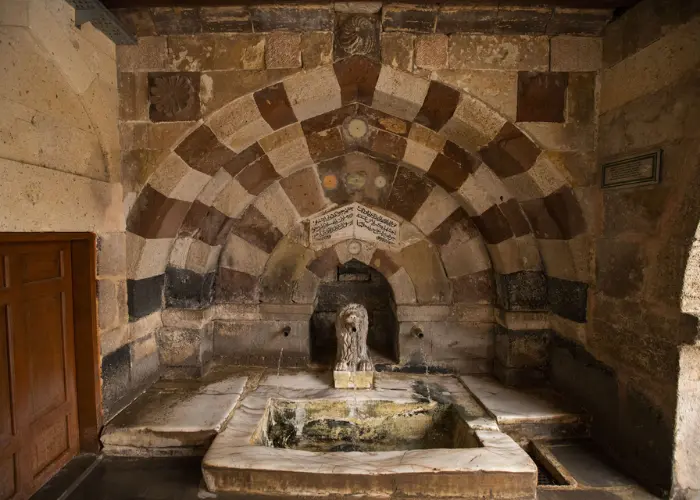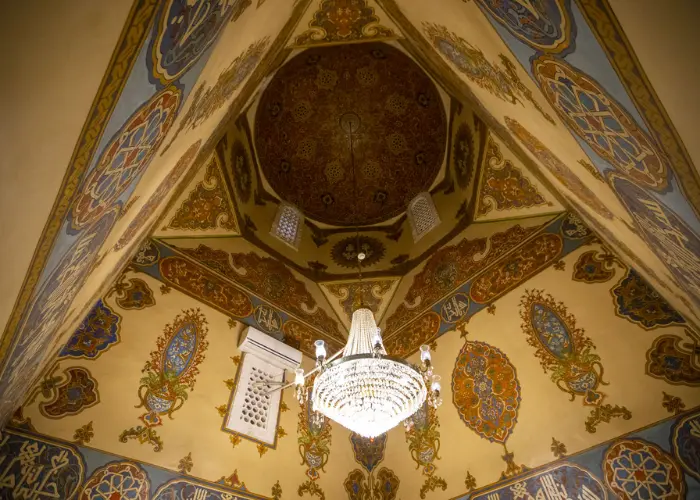Hacıbektaş Museum Entrance
Museums
Walk-in
Hacıbektaş Museum Entrance
Museums
Price Without Pass: Priceless
Free with Cappadocia Travel Pass®
Your digital pass includes:
Free access to 35+ top Attractions
All digital, Show&Go easy Access
Saving guarantee after purchase
Huge savings up to 70%
Starting from just €175
Cancel anytime!
Feel the Spiritual Atmosphere All Around You
One of the greatest Turkish Sufis, Haci Bektas-i Veli lived in the Cappadocia region in the 13th century. As the hub where Bektashism evolved, the Haci Bektaş Museum is much more significant than a typical historical structure. The Museum houses manuscripts, examples of calligraphy, and other relics from the Bektashi order.
About The Hacıbektaş Museum Entrance
Mobile ticketing - No need for a printed voucher, we're digital!
Duration - Unlimited Free time.
Instant confirmation - No reservation needed - instant confirmation
Highlights
Discover thousands of years old manuscripts, calligraphy samples, and more
Have a glimpse of the lives of Sufis
Feel the spiritual atmosphere of the Bektasi culture
Includes
Entrance to Hacibektas Museum
Details
There are three primary sections at the Hacibektaş Museum. A large fork-shaped gate leads into the first section. Through the Üçler Gate, one enters the second courtyard. Through the Atlilar Gate, one can access the third courtyard. In the third section, the entrance of Father's House, which was built incrementally between the 13th and 16th centuries A.C. and includes the tomb of Haji Bektash Veli, is where a dervish experiences a period of tribulation and sorrow. There are various other tombs in the museum.
Archeological relics are shown in the first two sections following the entry, which are comprised of artifacts from the Sulucakarahöyük Mound excavations that took place between 1967 and 1976.
Hours & Meeting
Opens every day
Opening time: 08:00
Closing time: 17:00
How To Get There?
Savat Mah. Kayseri Cad. No:5, Hacibektas
All About Hacıbektaş Museum Entrance
The Hacbektaş Museum is divided into three major divisions (courtyards). A large fork-shaped gate leads into the first courtyard. To the right of the entry lies the Üçler Fountain. Through the Üçler Gate, one enters the second courtyard. The second courtyard has the Lion Fountain, Soup Kitchen Baba Mansion, Soup Kitchen, Square Pool, Guest House, Square House, Cellar House, and Dedebaba Mansion. Through the Atlilar Gate, one can access the third courtyard. The courtyard has the Atatürk Corner, Father's House, Balim Sultan Tomb, Blackberry Tree, Burial Area, and Private Garden. A dervish experiences a period of hardship and suffering in this location, the middle portal, masjid, and the grave of Haji Bektash Veli. Father's House was built gradually between the 13th and 16th centuries AC.
The Father's House, which included the tomb of Haji Bektash Veli and was built gradually between the 13th and 16th centuries A.D., consists of an entrance, a room where a dervish undergoes a period of testing and suffering, a middle portal, a mosque, Kirklar Square, a private garden, and the Güvenç Abdal Tomb. The symbolic coffins of Balim Sultan and Kalender Elebi are kept in the Balim Sultan Tomb.
Archeological relics are shown in the first two sections following the entry, which are comprised of artifacts from the Sulucakarahöyük Mound excavations that took place between 1967 and 1976. It is worthwhile to view the section/animation of the mound on a plateau as well as the chronological display supported by introductory boards about Sulucakarahöyük, which had been continually inhabited from the Early Bronze Age through the Roman Period. With the help of introductory panels, city coins from the area are shown between the Archeology Section and the Ethnography Museum. In a room housing ethnographic works, you may see carpets and rugs from the Ottoman era, stonemasonry artifacts, women's apparel and accessories, and everyday objects on display.
On December 22–23, 1919, while returning to Ankara from the Sivas Congress, Gazi Mustafa Kemal Pasha stopped in Hacbektas and remained there for one night. In 2001, the Atatürk House was converted into a museum. The museum displays ethnographic pieces.
About Haci Bektas-i Veli
Haci Bektas Veli is the practitioner of Hoca Ahmed Yesevi’s doctrines in Anatolia. The Bektashism, or Haci Bektas Veli's worldview, spread beyond of Anatolia to the Middle East and the Balkan nations. In a humorous way, when he shared his ideas and teachings about Love-God-Man and Humanity with us in 1948, Haci Bektas served as an inspiration for the United Nations Human Rights Declaration.
Seyyid Ibrahim Sani and his wife Hatern Hatun had Haci Bektas-i Veli in Khorasan most likely between the years of 1243 and 1248. His parents' guidance helped him develop an enlightened mind and vision. Then, after his studies in literature, philosophy, mathematics, and physics under the direction of Hoca Ahmet Yesevi. Following his studies of Islamic mysticism, he began to look for the way of the limitless love that was within his heart. This led to his pilgrimage to Mecca, followed by trips to Syria, Persia, and Iraq. Coming back to Anatolia after such a lengthy voyage shaped a special spiritual figure.
Gallery
Advantages Of Cappadocia Travel Pass
Cappadocia Travel Pass comes with several benefits. Price reduction is one of the biggest benefits but surely not the only one! You can not only save a lot of money by purchasing a Cappadocia Travel Pass but also save a huge amount of precious time by skipping long queues with your pass. Feel like a VIP unlocking the doors of the top attractions and experiences in Cappadocia. Moreover, you can even fly over Cappadocia with a DISCOUNTED hot air balloon and get to experience the mysterious fairy chimneys from the sky!
Hacıbektaş Museum Entrance Frequently Asked Questions
Who is Haci Bektas?
What is there to see in Hacibektas Museum?
The Haci Bektaş-i Veli Museum houses manuscripts, examples of calligraphy, and other relics from the Bektashi order. The tomb of Hacı Bektaş-i Veli is also in the museum.
Is Haci Bektas Museum also a mausoleum?
Yes, the tomb of Haci Bektas is in the museum and you can visit the mausoleum.
Other Popular Attractions

4.8 out of 5 stars
Cappadocia Travel Pass has an average rating of 4.8 /5 from 1075 reviews
Read all traveler reviews →







Muslim mystic, saint, sayyid, and philosopher Haji Bektash Veli was from Khorasan and lived and taught in Anatolia. He is admired by Alevis for having an esoteric, logical, progressive, and humanistic interpretation of Islam.